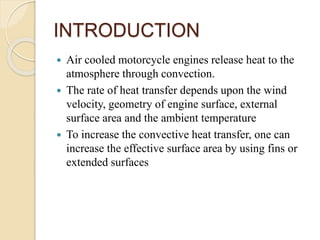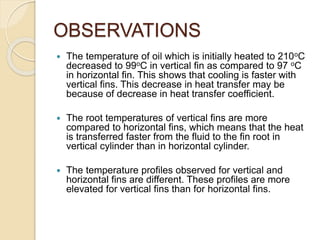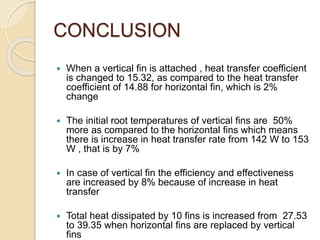HEAT TRANSFER ANALYSIS OF RECTANGULAR FIN PPT
- 1. HEAT TRANSFER ANALYSIS OF RECTANGULAR FIN ON AN AIR COOLED IC ENGINE Done by : Sri Lalitha Swathi .S (11011A0333) Ashish Kumar.T (11011A0306) Sankdeep. K (11011A0326) Md Rassam (11011A0353)
- 2. INTRODUCTION Air cooled motorcycle engines release heat to the atmosphere through convection. The rate of heat transfer depends upon the wind velocity, geometry of engine surface, external surface area and the ambient temperature To increase the convective heat transfer, one can increase the effective surface area by using fins or extended surfaces
- 3. OBJECTIVE The main objective of the project is to analyse and compare the natural heat transfer of solid vertical fin with that of a horizontal solid fin by conducting experiment.
- 4. EXPERIMENTAL SETUP The experimental setup consists of cast iron as cylinder bore of an old splendour bike and aluminium alloy 6063 as the fin material The fin was machined to a thickness of 5mm and to the length of 25mm from the root of the fin. The cast iron cylinder is machined to an outer diameter of 70mm and inner diameter of 50mm. The height of the cylinder is 68mm. SAE 5W-20 engine oil is used as the heated fluid element. Two heating coils of 50W each are used to heat the oil to required temperature. Temperatures at different parts of the fin are measured with the help of K-Type digital thermocouple. Infrared thermometer is used to measure the oil temperature at regular intervals of time. Cotton wool, wooden lid are provided for insulation.
- 5. EXPERIMENTAL PROCEDURE The hollow portion of the bore is filled with SAE5W20 engine oil and heated to 210 ͦ C using two heater coils of 50W each. The power input is switched off and a wooden lid is placed immediately above the cylinder and necessary insulation on the bare cylinder is provided using cotton wool. Using K type thermocouple the temperatures at fin root and tip are measured at 0,30,60,90 and 120 seconds. The readings are tabulated. Also, the temperatures of oil at regular intervals are measured using thermometer and are noted. The heat release is obtained from multiplying the heat capacity of the heat storage liquid by the difference between initial and final temperatures of oil at air velocity of 0km/hr. The experiments are carried out at ambient temperature of 32 ͦ C.
- 6. GRAPHS OF READINGS 0 20 40 60 80 100 120 140 0 50 100 150 200 250 tip/roottemperature oil temperature tip/root temp vs oil temp for vertical fins Toil vs Troot Toil vs Ttip
- 7. 0 10 20 30 40 50 60 70 80 90 100 0 50 100 150 200 250 root/tiptemperature oil temperature root/ tip temp vs oil temp for horizontal fins Temperature of root Temperature of tip
- 8. OBSERVATIONS The temperature of oil which is initially heated to 210oC decreased to 99oC in vertical fin as compared to 97 oC in horizontal fin. This shows that cooling is faster with vertical fins. This decrease in heat transfer may be because of decrease in heat transfer coefficient. The root temperatures of vertical fins are more compared to horizontal fins, which means that the heat is transferred faster from the fluid to the fin root in vertical cylinder than in horizontal cylinder. The temperature profiles observed for vertical and horizontal fins are different. These profiles are more elevated for vertical fins than for horizontal fins.
- 9. CONCLUSION When a vertical fin is attached , heat transfer coefficient is changed to 15.32, as compared to the heat transfer coefficient of 14.88 for horizontal fin, which is 2% change The initial root temperatures of vertical fins are 50% more as compared to the horizontal fins which means there is increase in heat transfer rate from 142 W to 153 W , that is by 7% In case of vertical fin the efficiency and effectiveness are increased by 8% because of increase in heat transfer Total heat dissipated by 10 fins is increased from 27.53 to 39.35 when horizontal fins are replaced by vertical fins
- 10. FUTURE SCOPE As the orientation of the fin plays an important role in heat transfer. There is scope of improvement in the heat transfer of air cooled engine cylinder by choosing vertical over horizontal by varying the Fin thickness of vertical fin Orientation of the fin Different types of engine oils can be used inside the bore The present work is limited to experimental setup, hence numerical techniques can also be used Different other fluids can be used as working medium for future work
- 11. THANKYOU










